With this article, I want to feature my good old acoustic guitar: a Gibson MK-81 from 1976.
I got this guitar more than 20 years ago. I was looking for an acoustic guitar and was trying out all the guitars in that shop. After a while the shop owner brought one more from some room in the back, saying I should try out this one, it was special. This was the Gibson MK-81, and in fact it sounded different from all the other guitars, it sounded more ‘expensive’ in a way, with a warm bass and brilliant treble, like a great HIFI speaker compared with a cheap one. He told me that this guitar had been damaged damage and was not professionally repaired (the bridge had solved from the top and had been glued back to its position, additionally fixed with two screws), and that it normally costs more than 3 times the money I wanted to spend.
Well, we agreed on a deal (I had to part from a nice Tokai Telecaster copy I had back then) and I took this guitar home with me. The damage could be repaired professionally for about 100,- € by the way.
The MK series
I had never heard about these guitars before, and there was not much information available. Remember, this was before the Internet, so you had to look through guitar books at the shop when searching for a particular information. Today it is so much easier. The story behind the Mark series seems to be like this:
In May of `73 Gibson began the Mark story by contacting Dr. Adrian Houtsma, Professor of Acoustic Physics at MIT, to confirm some research Gibson itself had initiated. Receiving a favorable review, Gibson then went to Dr. Kasha, who was at the time, a chemical physicist working as Director of the Institute of Molecular Biophysics at Florida State University. Combining the findings from Gibson` R&D department and Drs. Houtsma and Kasha, the company finally landed on the doorstep of well known luthier Richard Schneider, who was charged with making the scientific information practical, designing a guitar that fit with Gibson`s aesthetics and capable of being put into production. The Mark series was born…
The Mark series was no commercial success, rather the contrary as it seems. It turned out that science alone was not capable of building perfect guitars made of wood, a material that is unpredictable because each piece of wood has individual features. After only 3 or 4 years Gibson dropped the Mark series again.
But these guitars were not really bad, and I heard from many owners how much they love their MK’s. The complete series consisted of 5 models, the MK 35, the MK 53, the MK 72, the MK 81, and the MK 99 (the higher the model number, the better the materials, and the higher the price).
Here is a page from a Gibson catalogue from that time that shows the different features of the different models:
The MK-81
Both the rim and back of my MK-81 are made of solid (!) rosewood (possibly Brazilian, but not sure), the top is solid spruce. The neck is curly maple, the fingerboard is ebony with mother-of-pearl inlays. There are some fancy details that make sure that this was the top-model of the production range (in fact, the MK-99 seems to be custom-made by luthier Richard Schneider himself only) like the gold plated hardware or the black and red bindings.
It is a special guitar in fact. It is very deep, and the body and headstock shape looks somewhat unusual. The sound is warm and bright, a bit bell-like. With the heavy Gibson jumbo frets and the “fast” neck shape it plays almost like an electric.
Pictures of my MK 81
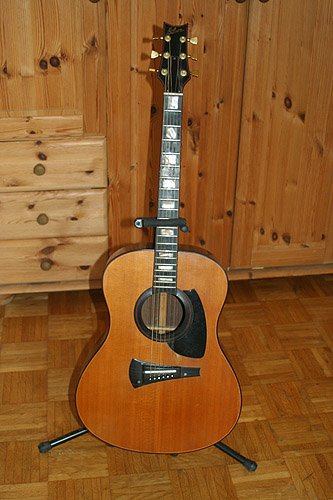
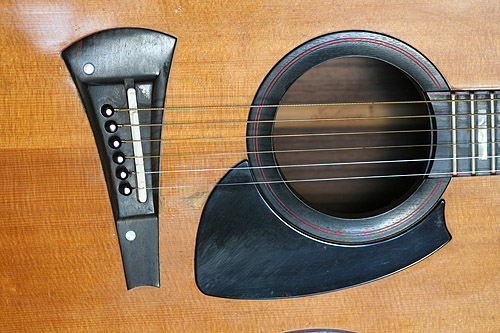
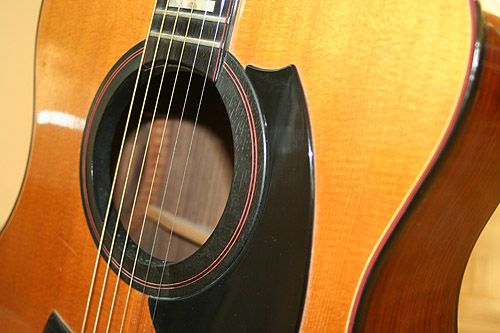
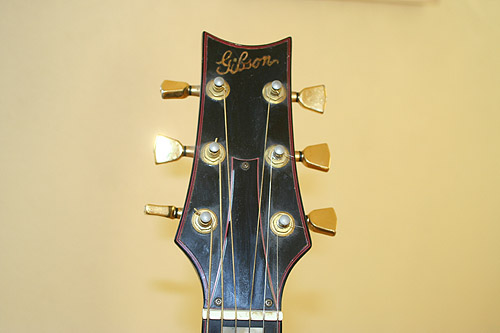
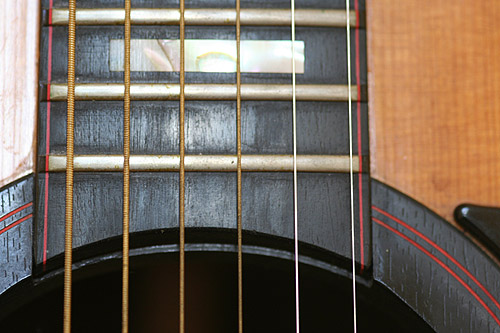
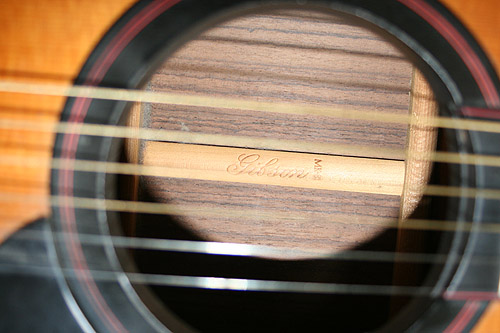
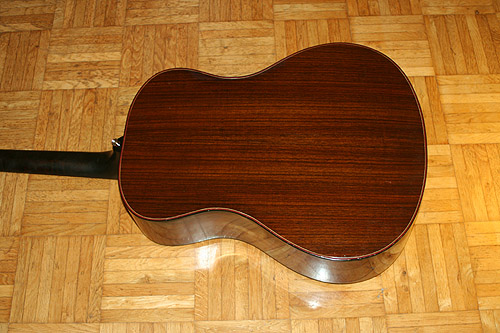
Youtube videos
Two of my latest youtube videos feature this guitar.
If you want the full story and more details of the Mark series, see this article in vintage guitar magazine.
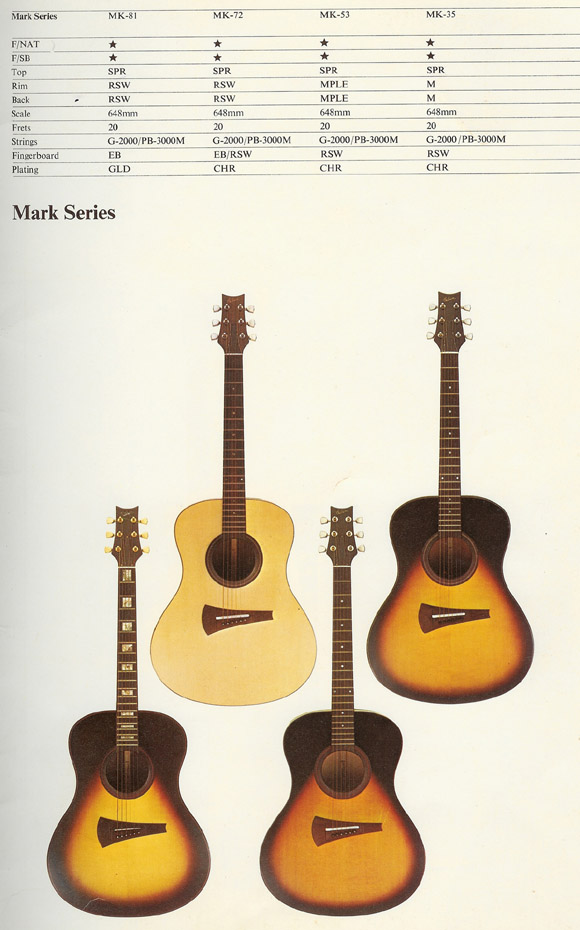
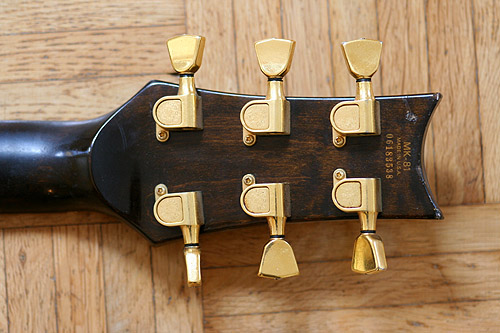

41 thoughts on “Guitar portrait: 1976 Gibson MK-81 acoustic guitar (Mark series)”
This guitar looks fantastic, I’d be happhy to try it at least for several minutes, the sound must be very cool! You just don’t imagine how much I like old guitars…
I own a MK-35 I bought new in 1977 & love it. In fact when my time comes, it will be inherited by my youngest son, who knows the value of this fine instrument & learned to play on the same. I’ve been playing since 1962 & am 54 yrs young as of this writing(10March2010). It’s just a shame the way the purists run down guitars that don’t have their “Seal of Approval”. Oh well-it’s their loss. All I can say is-“Enjoy”! (notice my e-mail address?)
MK Series! These guitars are for life! I have one of the original MK-81 demonstrators, built by master luthier Ricardo (Richard) Schneider, who was involved in Norlin’s (Gibson) MK Series designs during the 1975-1977 period with Dr. Michael Kasha, (Univ. of Florida). I got mine from the Norlin’s Sales Rep for Tennessee at the time, who got it as a “back door” instrument straight from Schneider when the whole project went kaput and Norlin ordered all demonstrators picked up and destroyed!! The guitar is Sunburst, similar to the one shown at the bottom left of the catalog page, except everything was done by Schneider himself, the detailing and the woods are just incredible. Mine has been kept in its case since 1980, it has the original unused pickguard still in its factory envelope with instructions, and it came with a total of 4 bridge saddle-inserts, 2 in ebony/bone, 2 in Melamine, all in different heights. The sound is penetrating, cutting, silky, smooth, loud, too many qualities to put in words, and the beauty of the instrument is like no other Gibson or Martin or any other guitar I have ever seen since I started playing in 1963.
One observation about your MK-81: the pearl dots on each end of the bridge are not original, mine does not have them, and neither do the catalog pictures. Those are reinforcements, apparently your bridge was being pulled off. congratulations, these guitars are simply, unique.
here’s more info. on my MK-81:
I first saw and heard a MK-81 guitar in mid 1978 in Los Angeles, Calif., when I was enrolled at GIT (Guitar Institute of Technology). Someone from Norlin/Gibson showed up at GIT with the guitar and was demonstrating it to Howard Roberts, Ronnie Eschete, Don Mock, and the other famous instructors there while we all listened and each instructor played the MK-81. (not sure but I think the guy from Norlin/Gibson was called Bruce Bolin). The guitar had a fantastic volume and richness of harmonics that none of us had ever heard from an acoustic guitar, even sitting in the back with 40 other students in front of me. Next day I went around the Hollywood guitar stores looking for a MK but incredibly, nobody had heard of the MK Series. I kept checking but all I heard from the guitar stores was about “The New RD Series”. (another Norlin fiasco). I graduated in 1979 from GIT and moved to Nashville Tennessee; I kept going around guitar stores in Nashville and it was the same story, but in one of those stores, one lady told me: “if anybody knows anything about those MK guitars, it would be “Mr. Jim” at so-and-so music store (names changed because “Jim” asked me to not reveal his name); So off I went looking for “Jim”. Turned out he was the Norlin Sales Rep for the South East. Jim kindly told me to call back in a month and he would have some MK’s for me to try out. When we met again, he had a MK-35, and MK-53, and a MK-72, all with the ‘flat’ finishes and the guitars were practically falling apart at the seams, and they sounded horribly “flat”. I told Jim that’s not what I saw at GIT and he smiled and told me “you probably saw one of Schneider’s demonstrators, (the MK-81 model), I have one of those but I’m not selling it, too many memories”. Well, I kept calling and harassing “Jim” to show me the guitar. A year later, I called him again and he invited me to his house to see the guitar. That was it! it was a gem of a guitar, hand-built by a Master Luthier, with a finish like glass. After a few more months, “Jim” agreed to sell me the guitar if I paid his price, and I did. Took me a few more months to pay him but I bought it and I still have it.
Thanks for your interesting comments 🙂
You are right, the pearl dots on the bridge of mine are not original. When I got it it was in a bad state: the bridge seemed had loosened and was then screwed to the top ! I had it repaired and the luthier covered the holes with the dots.
I also love mine very much, it sounds so special and nice. Never understood why it the series flopped.
I was told by “Jim” the Rep that the Mark Series flopped because the production examples did not meet any quality standards, or those set by Richard Schneider who built the prototypes; Norlin wanted to do a quick job of assembly, (“we gots to move these, refrigeraters…”, but the Mark guitars could not be produced at speed and the result was a disaster. When Schneider saw the first batch of Mark guitars, he was disgusted and quit, Dr. Kasha quit next, and corporate chaos ensued.
Hi, recently I’m too the very very happy owner of a mk-81.
It just plays lovely and the sound is so nice.
But i’ve got some troubles decoding the serial number. Mine says on the back of the head: “MK-81 made in u.s.a 00222255”.
I can’t figure out for myself the year it is build etc.
According to the seller the guitar is build in 1976 and I’m the 4th owner, the first owner was a Gibson employee and they sold it to a couple who owned the guitar until 9 years ago and recently it got it.
Hopefully anyone of the other MK-81 owners now how to decode the serialnr.
During the period from 1975-1977 Gibson used a transfer that had eight digit numbers, the first two
indicate the year, 99=1975, 00=1976 and 06=1977, the following six digits are in the 100000 to 200000
range.
Some pics of my MK-81:
http://picasaweb.google.co.uk/frdako/Mk81?feat=directlink
I own a MK81. I think it is pretty simular in serial number. It is number 06183557
During the period from 1975-1977 Gibson used a transfer that had eight digit numbers, the first two indicate the year, 99=1975, 00=1976 and 06=1977, the following six digits are in the 100000 to 200000 range.
Hi! I have this guitar, I love it and have had it many years, anyone know what the value is?
I got my MK53 from a friend that owned a music store the guitar looks just like it did the day I bought it in 1978 it sounds great and I would not sell it for any price it will be passed on to my son I know he will take care of it as I have throught the years. the style is different from Gibson normal style but but I like it as much as my model J-45.
MK 72 ALL THE WAY. WOULDN’T SALE MINE FOR ANY PRICE!!!!!!!!!!!!!!!!
The MK 72 & the 81 box are made from same material.Both sound great but usually vintage guitars sound sweet as wine, better with time!But the MARK series guitars are among the most talked about guitars on he planet.Sure some had issues, some didn’t.thats the way it is with everything.The MK was a challenging era in GIBSON’S history,thats what makes them so rare and collectable,iv’e had many many many guitars,none play or sound as well as my MK 72.And it’s also the only guitar that people can spend hours talking about it’s history.There will never be a more interesting gibson guitar than this one.There will come a time when the average person can not afford an MK.The prices are starting to rise so hold on will see just how far they will go,if you have one hang on to it you want be sorry. average now IS $1200 – $1800 mine is not for sale at any price! THANK YOU GIBSON! THANK YOU!
Hi
I bought a Mk53 in 1980 from the Sound Centre in Los Angeles, while I was on holiday. I was gently co-erced into buying the guitar and I’ve never regretted it! Imagine being a full blown rock star and all the attention you would receive. Well that’s what happens whenever I take the MK out of it’s case, I have a crowd around me. It never fails! “WOW whats that?” they say, “where did you get it, Wow, what a sound!”. It is a rare instrument.
It’s happens every time. At the pub, at my kids school, on a gig, at the luthiers! The guy who looks after it for me keeps hold of it for weeks!
Once I had a car delivered by a guy who afterwards sat playing the guitar for over 3 hours, causing him to miss his train back to London! MKs have that effect on people.
It has gotten better with age and is my No.1 guitar. I joined an acoustic band and after the usual “Wow where did you get that” routine, I gained a grudgingly healthy respect from the other members of the band, just ‘cos of the MK. It was as if they were saying to themselves, “He knows what he’s doing!”
But, the MK has its foibles. The plastic soundhole trim makes it very difficult to fit a pickup. Similarly, the bridge is not the standard type, being wider and replacements aren’t available easily (Gibson supplied aech new MK with 2 spare saddles!). This makes it hard to upgrade to an under saddle piezio unit. So, if you’re in a band and you want to be heard, you’ve only one option, buy another guitar! Thats what I did as I didn’t want any holes or marks on my beloved MK.
But then, you don’t get a crowd around you with a Yamaha! Nobody wants to know and do you know what? You just dont get that real sweet acoustic tone. It’s good enough, but not what you’ve been used to for over 30 years!
So, I content myself by playing and recording the MK (with a mic!)by myself, in the front room. Sheer musical bliss!
My Mk53 will be with me until I pop all my strings and instructions will be left to pass it on to someone who will fully appreciate it.
I’d like another one, just for fun, to say that I’m a collector, but I firmly believe that an MK comes to you. If you go looking for one, they can’t be found.
I’m patiently waiting………….
Thank you Gibson, thank you.
Mike R
Wow, that’s what I’d call a love story 🙂
I wonder in how far yours sounds different from mine as you have a maple body with a rosewood fingerboard, while mine has a rosewood body and an ebony fingerboard.
I’ve never found another MK owner to sit down and jam with. I guess that proves their rarity. Yep, mine is a maple body and rosewood fingerboard and I,ve seen pictures of some of the other combinations of woods/body/fingerboard/finish. I’d love to compare mine with others.
I did find a MK35 with the sunburst finish in a guitar shop. It hadn’t been looked after too well and it had old strings and had been knocked about a bit. Because of that, I didn’t rate the sound of it and I felt that it was overpriced at £450(No case). But thinking about it later, maybe I should have made an offer as I could have cleaned it up and sorted it out.
When I went back, it had gone! So it wasn’t to be. They sold it for £350 and included a case of sorts.
So now my mantra is “Carp Diem”, in other words, “Dont hesitate when you find an MK, just buy it!!!!!”
But as I said I’m patiently waiting!
just my opinion but “Mark” guitars don’t sound like anything else in the acoustic guitar world. That is exactly what you should understand about them. From the MK-35 to the MK-53 to the MK-72 to the MK-81, they are all acoustically-refined guitars in many ways, not your typical mass-produced acoustic guitar 🙂
I have noticed that MARK guitars are appreciated by Europeans more than by North Americans, maybe because European guitarists are more sound-sophisticated or sound-sensitive?? After all, it was Europe who produced Django’s Macaferri guitar and the Stradivari violins, both of which were “revolutionary” when they were introduced.
Can anyone tell me what the the letters BGN means on the headstock of my Gibson MK81 it’s very hard to see the serial numbers they are very faint.I love this guitar it’s sound like nothing on earth I have heard before. People here in the uk say that there value is not very high around. £600 for a MK81 which I find very hard to see as there were only 428 ever made
BGN means ‘bargain’ see here for more info http://home.provide.net/~cfh/gibson.html#serial
“Gibson often marked inferior quality guitars as “seconds”, and sold them at a discount to dealers or employees. These markings were stamped into the wood on the back of the peghead. A “2” stamp is sometimes seen, designating a “second”, which had some cosmetic flaw. If there is a serial number on the back of the peghead, the “2” is usually seen centered above or below it. Also sometimes stamped was “CULL”, which is another designation of a second. Again, this stamp is seen on the back of the peghead. The worse Gibson reject is the “BGN” stamp, designating that instrument as a “bargin” guitar. These were only sold to employees at substantial discounts. This stamp is also seen on the back of the peghead. Sometimes the “BGN” is stamped vertically with the “N” below the “G” which is below the “B”. BGN instruments weren’t acceptable to Gibson as sellable to the public.”
My MK81 has got the same BGN letters on the headstock. My MK81 is fantastic, both sound and appearance (see pics in my earlier post). Maybe its wishful thinking but I read somewhere that in the days Gibson employees would mark BGN on guitars they wanted to buy themselves. Maybe true, maybe not. At least its a nice story…
FYI, Im also in the UK (London) and I bought my MK81 here in 2010 for 1100,- GBP
Hi – Enjoyed your article on your ’76 MK-81 – From the photos, it looks lovely! I’m desperately trying to find out more about mine – a ’76 MK-72 twelve string; from my research so far, I can find any record anywhere of the MK series having been built as 12-strings apart from a few MK-41s and about 12 MK-35 12-string prototypes… Any leads on where I could find out more?
Hi Again, Just in case you’re interested in having a look at the MK72 12-string from the previous post, I’ve put some pictures on:
http://jayem-andem.tumblr.com/post/65461771618/gibson-mark-72-12-string-these-are-some
Thanks – JM
Man, I loved reading through these even though they go back a few years.
I too have a Mk-81 bought it brand new in 1988 had sat in a store (new) I was told it had sat in the store for a coupe of years, I fell in love with the rich sound and knew I was getting a great guitar for the money. Six months after I got it, the ebony saddle split, I was really bummed because the company told me to call Gibson, which I did and they told me the warranty was good up to a year as long as I bought it new. It was then they checked and told me the guitar was more than a couple of years old being made in 1976! They fixed it for free, been trouble free ever since!
In the late 90’s I was looking for a guitar and I called Whechter out of Paw Paw, Michigan. I was talking with Abe Whechter and we started talking and I mentioned the MK-81 I had. He commenced to tell me that he learned the craft from Schneider and built the proto-types for the MK-81. The story related from my repair call to Gibson and in talking to Whecter was the same they tried to make a scientifically engineered guitar that would create an old guitar sound out of a production guitar.
Number: 00222211
I have loved this guitar for the past 25 years, will keep it and play it till I roll over!
Great story, my mk81 has got serial 00222255. So your and my mk might be close family of each other 🙂
Did Gibson also make a fl-59 mk?
There’s one of these for sale here; http://www.adverts.ie/acoustic-guitars/rare-vintage-gibson-mk81/6253814
I have no affiliation with the seller, just thought of it when i was reading the article. Might make someone happy. Looks pretty clean.
I have a Gibson Mark, probably a Mark 35, I bought new in Perth Western Australia for $A800 in 1977. It’s a great guitar, has aged well, plays brilliantly and I’ve had no trouble with it. It has the serial D344386 on the back of the head. However, it’s a long time since I’ve been able to buy a set of guitar strings with an unwound third string in Perth and I’ve lost track of the size of the strings to replace the wound string in a standard set with the appropriate unwound one. As I remember, Gibson used to supply two or three sets of strings (light, very light and extra light?) balanced for this guitar, but they no longer do and a query from me to Gibson a couple of years ago produced no result. Can anybody help?
I had never heard of a set of strings specially made for the MK guitars. What you want is a set of acoustic guitar strings with an unwound Third, that’s all.
And it depends on the gauges you prefer, for the MK guitars you don’t want to go too Extra Light, as in .009 E string, those are way too thin for an acoustic guitar. I would say .010 E string is about maximum. A .013 is about right for a B string, and an unwound Third G string would be between .018 to .020. The rest would be .028 for a D string wound, .038 A string wound, and a .046-.048 for the low E string wound.
if you go to eBay, you can also find acoustic guitar strings in Bulk packages, a dozen of this gauge, a dozen of that gauge, sold directly from China, for little money. The Chinese are manufacturing decent strings, they are doing a great service to us guitarists, don’t be fooled by “Brands”, since most everything is made in China nowadays.
if anyone is seriously looking to find a pristine MK guitar, I have a 1977 MK-81 with a special history, complete with all the factory accessories, (3 extra saddles, never mounted Pickguard still in its factory envelope, hard shell case and its key). I’ve owned it since 1980 when I purchased it from the Norlin (Gibson) Sales Rep for my area. The guitar has a Sunburst finish, shiny like glass and supposedly 3 were done in Sunburst of the 12 MK81 made in 1977. Incredible Brazilian Rosewood back and sides, Ebony fingerboard with beautiful abalone inlays. It was decorated by Richard Schneider himself and given to the sales rep as a demonstrator. The sound is rich and full of harmonics. Schneider’s “signature” Red binding was applied everywhere. The MK-81 was the top-of-the-line Mark guitar after the Custom-Order MK-99 of which it is said that only 3 were ordered, some say only one MK99 was made. I will sell my MK81 if I get the price I want, otherwise I will hold on to it. If you want pictures, contact me through my Kent 820 guitar website at: http://kent-820.webstarts.com/ I will ship worldwide but the buyer pays actual shipping cost, any currency conversion fees, and any fee charged by Paypal to me to receive payment.
I have a very special MK 81. As the story goes, a woman walked into the Blue Ridge Pickin’ Parlor in Reseda CA and handed Kenny Blackwell (luthier and great mandolin player) a shopping bag with a guitar neck sticking out of it. It seems she thought her husband was cheating on her and she stomped it into little pieces. Well, he wasn’t cheating on her and now she wanted to see if it could be fixed. Kenny took a look at it and told her to buy a new guitar. She asked if it was worth anything and he said he’d give her $25 for it just to see if he could put it back together. I was told it took him about a year in his spare time to put it back together. It appears he only had to “make” one small patch on the front and managed to get the entire guitar repaired. I got the guitar from a guy who bought it from Kenny. You can see the cracks in the back and there are several patches inside. I can’t believe what a great guitar this is even after such a disaster. I love it and will never part with it. I have an LR Baggs pick-up installed by Renson in North Hollywood. It sounds, plays, and looks (despite the repairs) great. It is my all time favorite acoustic guitar.
Hi you made the right choice ! Dont part with it ever! i fell in love with it when it first came out ! i was still at school . i just saw it from ads in music mags—guitar player . i dont think they ever made it to Australia . i probably have an import . I Love it .mine has a passac piezo system (aus) installed and it sounds the same plugged in or acoustic . I bought it s/h with case
Sound sweet,crisp ,articulate balanced –not a loud guitar but heaps of toneeeeeee!
Hi, also a MK 81 here. Questions for all other owners: 1. On my MK 81 the frets are lower than all other guitars i played so far. Even bendings are hard to perform. I bought mine new in 1981. Are your guitar also this kind of Fretless Wonder? 2. The bridge on my MK81 separated from the top like Ingos. Is this a common problem?
I have an MK 35 and I can only agree with all the previous comments about the tone and playability of this guitar. I bought in one day when idling in London’s Denmark St, with no thought of acquiring another instrument, though like all guitarists I always seem to keep my eyes open for just one more…
It was in an upstairs room full of other guitars, including an arch-top that I played first – I own an old European archtop, so have some affinity for them. This one, however, though polished and recently re-strung was cold; cold, like it hadn’t been played in years, and had lived under someone’s bed, with the tone dense and tight – so I looked at various other ones around the room, using a trick that worked well when I reviewed guitars for a magazine: just take out the price tag from between the strings and strum once across the strings by the soundhole. When you hear one where the sound leaps out, you know that’s the one to take down and find whether it’s any good to play. I tried it on a Gibson Hummingbird, and then various others on the wall but nothing really inspired me, so I looked down at this rather unexciting Gibson guitar on a stand, having ignored it in favour of the bigger names on the wall – of course, the tone just jumped out.
I played it, loved it and promptly went home, dug out a lovely, but largely unused Gibson BB King model I’d bought cheap (really I’d wanted the original ES-355 model BB played!) and returned to the shop demanding a straight swap. Luckily, the shop guy knew a deal when he saw one and I walked out with the MK 35, which I still have and is the pinnacle of my small selection of working acoustics…
Thanks for sharing the information I have gained from you.
Kindly visit us ibiz.ie for shopping
I’ve had a MK35 since the early 80’s and with the years it just gets better and better. The notes ring for ages so that orchestral feel is always there. I’ve just done an experiment…plucked the G string on the 9th fret (E4) with my thumb flesh and immediately dampened it. Even with my tinnitus I hear the guitar ringing for 15 seconds! So you might think that’d limit the kind of playing and style you can use… well, it’s an unusual sound, but I find it great for everything.. strumming, soloing, picking. It’s a wonderful instrument, and over the years it’s been painful to read the incessant criticism and debasement of this guitar in guitar forums etc. I’ve never been able to understand it. I’ve recently restrung it with some Elixir 11025. It sounds fantastic! I’ve got one problem, though. I need another saddle. Will I have to get one made specially, or does anyone know of a supplier or a webpage where an original MK35 saddle can be found?
Hi Paul,I see it’s been a while, but did you ever find a saddle?I have a MK-53 I recently did some work on and broke the only saddle I had left.Can’t find one anywhere.Any help would be appreciated.
Hi I have an Mk 35. Since 1976 was bought new. Was my brothers guitars and I was offered good money many times and no I wouldn’t part with it sounds better then my D28 Martin Whom as the mk series hold on to them if you enjoy the sound of a Gibson guitar I also own a humming bird